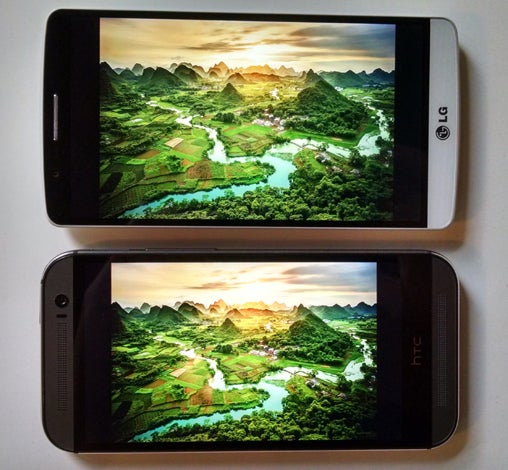Dilbar Dilbar Full Hd 1080p Video Song Download 2018
![]()
By , Contributing Editor, Computerworld |
About |
Not your average Android news — a diverse mix of advice, insight, and analysis with veteran Android journalist JR Raphael.
Quad HD vs. 1080p: A real-world display comparison

I'm starting to think I need to upgrade my eyes.
Don't get me wrong: I've got perfectly good vision. (With my contacts in, at least.) But smartphone manufacturers are now telling us we need super-high-res Quad HD screens on our mobile devices -- and damn it, I can barely tell the difference between them and the already-impressive 1080p screens on smartphones today.
So I must need some sort of special superhuman vision. Either that or, you know, we really don't need these Quad HD displays after all.
Pick whichever interpretation you prefer. What I can tell you for sure is that I've been spending a lot of time using the LG G3, which packs a futuristic-sounding 2560-x-1440 538-pixel-per-inch display, and comparing it with the HTC One (M8), which has a more typical 1920-x-1080 441-pixel-per-inch screen. Both phones use LCD panels, and both have been praised for boasting among the best smartphone displays you can feast your eyes on right now.
And you know what? In most real-world use, the differences between the two are virtually impossible to detect.

That's not to say the G3's screen doesn't look fantastic -- because it does. True to its rep, it's easily among the best screens you'll see on a smartphone today. And ultimately, that's what really matters.
But LG is pushing hard (as other manufacturers likely will before long) to convince us that having a Quad HD display delivers some monumental leap forward in the smartphone-using experience. The company even used tricky imagery during its G3 launch event to try to demonstrate how significant of a bump the extra resolution would bring in picture quality.

In reality, though, we're reaching the point where packing more pixels into a palm-sized display just doesn't make much of a practical difference. To be sure my visual memory wasn't deceiving me, I decided to perform a series of direct side-by-side comparisons beween the G3's Quad HD display and the M8's 1080p screen -- just a little something to supplement my more casual day-to-day-usage-based observations.
First, I set both phones at 100-percent brightness to eliminate that as a variable. Then, I compared the following visuals with one phone right next to the other:
• A series of five high-res photos taken by the talented Trey Ratcliff
• A series of Web pages loaded in the Chrome mobile browser, including the Android Power home page, set to desktop view; the Google News home page; and the Facebook home page (a.k.a. the News Feed)
• A series of apps, including Google+, Google Drive (with a text-based document pulled up), and Flipboard
• A series of videos, including several HD clips streamed from YouTube and one 4K-level video that came preloaded as a demo on the G3
So how'd things stack up? Let's break it down:
With the images, there was no discernible difference in sharpness or detail between the two devices. I could tell a difference in contrast and color saturation, but those factors aren't directly related to display resolution -- and in fact, the images on the M8 actually looked a bit better to me in those regards.
With the Web pages, if I looked very closely at small text on the fully-zoomed-out desktop view of a page -- like the blue words under "Hot Posts" in the screenshots shown below -- the text appeared ever-so-slightly sharper on the G3's display. But we're talking an extremely subtle difference -- one you'd notice only if you were studying the two phones closely side by side. It's also a difference that generally won't be too meaningful in real-world terms, since most Web pages are formatted for optimal mobile viewing (and since most of us would simply zoom into a page if its text were uncomfortably small).

Viewing the same Web page side by side on the G3 (left) and M8 (right)
With the apps, there was absolutely no noticeable difference when moving from 1080p to Quad HD.
With the type of videos most of us watch most of the time -- that is, those that aren't presented in 4K-level resolution -- there was also no noticeable difference in appearance between the two phones.
And then there's the 4K video: Not surprisingly, the clip that came preloaded on the G3 did look a bit more detailed on the Quad HD display -- but we're still talking about a fairly subtle visible difference, and one that won't come up terribly often in most day-to-day use.
I didn't want to trust this type of comparison only to my own eyes, so I asked several other people to view the same set of samples on both phones and tell me which, if either, display looked better to them in each circumstance. All of the people owned and regularly used smartphones. A couple of them had heard of the G3, but most went in with no preconceived notion of which device was supposed to have the upper hand.
And you know what? Not a single person expressed a strong or consistent opinion about one device's display looking better than the other. The responses ranged from "hmm, pretty close" to "maybe that one looks a little bit better?" -- with the "winning" phone varying from one instance to the next.
That's by no means a scientific sample, of course -- just a small collection of average-user impressions to balance out my more targeted observations.

All said and told, the bottom line is this: LG's G3 has a gorgeous display that's among the best on the market. It provides fantastic image quality that's bound to satisfy even the most discerning eyes. But the whole Quad HD element? That's more about marketing muscle than anything.
At least, until our superhuman vision upgrades arrive.
SEE ALSO:
• LG G3 deep-dive review: Third time's (almost) the charm
• Is the LG G3 'the best Android phone ever'? Well...
• Just how big is the LG G3? Here's some visual perspective
Contributing Editor JR Raphael serves up tasty morsels about the human side of technology. Hungry for more? Join him on Twitter or sign up for his weekly newsletter to get fresh tips and insight in your inbox every Friday.
Copyright © 2014 IDG Communications, Inc.
Dilbar Dilbar Full Hd 1080p Video Song Download 2018
Source: https://www.computerworld.com/article/2476330/smartphones-quad-hd-vs-1080p-a-real-world-display-comparison.html

0 Response to "Dilbar Dilbar Full Hd 1080p Video Song Download 2018"
Post a Comment